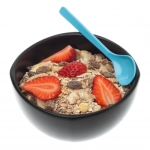Raspberries to Promote Heart Health
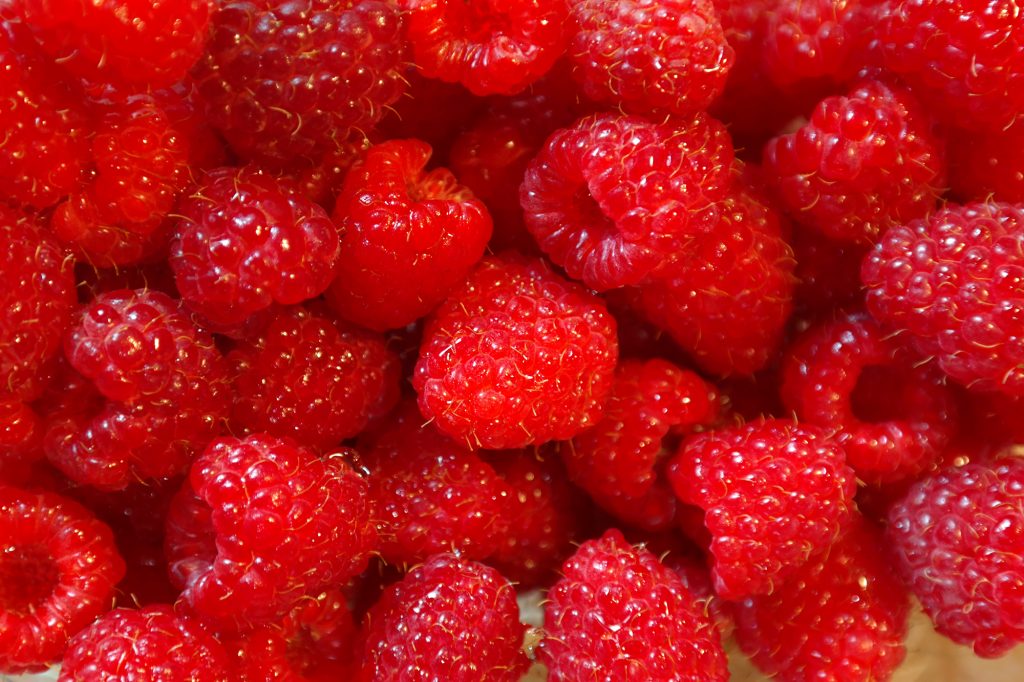
Raspberries are low calorie, convenient, great tasting, and provide a variety of nutrients. An excellent addition to your diet.
Fiber to lower cholesterol
Fiber is a key nutrient to combat high cholesterol levels and promote heart health. Dietary fiber binds to cholesterol in circulation and helps remove it from the body. Raspberries provide 12.5 grams/100 kcal (Calories).
For comparison…
High fiber cereals = 6 g fiber/100 kcal
Apple = 4.6 g fiber/100 kcal
Banana = 2.9 g fiber/100 kcal
Grapes = 1.3 g fiber/100 kcal
Most American’s consume about half the daily fiber recommendation of 25 to 35 grams per day. Raspberries are a useful tool for easily increasing your fiber intake. One cup of raspberries provides 8 grams of fiber.
Anthocyanins to lower blood pressure
Endothelial function is compromised with atherosclerotic disease. By providing the body with enhanced oxidative defenses, such as anthocyanins, you increase the nitric oxide released to relax blood vessels leading to vasodilation. This vasodilation promotes lower blood pressure levels. The anthocyanins found in raspberries have been shown to promote vasodilation of blood vessels in studies.
A little chemistry explanation
Quick chemistry lesson so you can better understand a couple terms.
Continue reading
Lower Blood Pressure with Blueberries
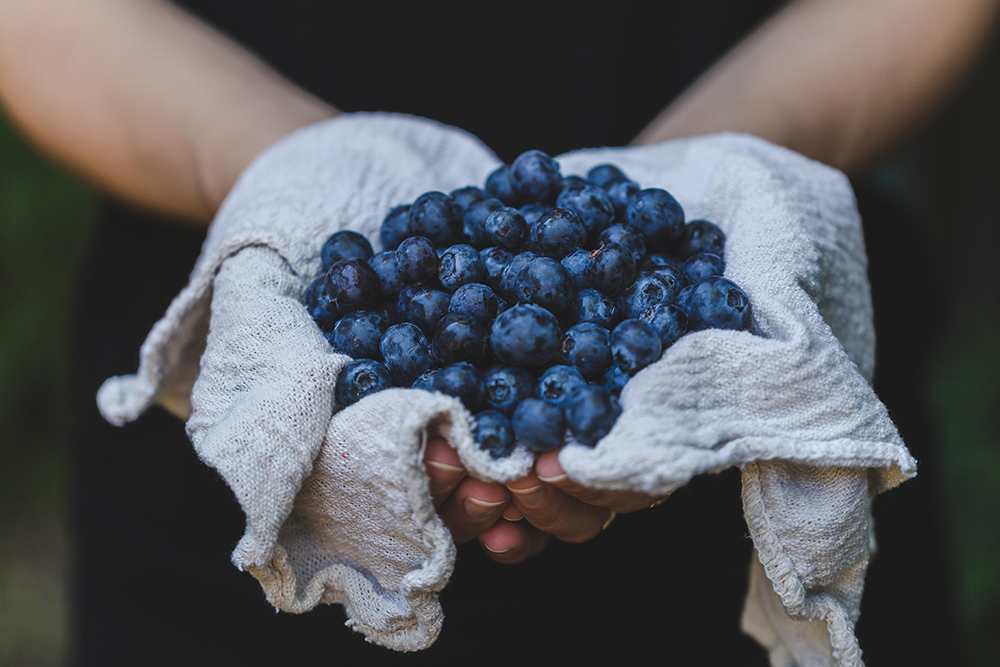
There is trial data indicating blueberries help reduce both systolic and diastolic blood pressure.
This double-blind, placebo controlled trial assigned 48 women to receive either 22 grams of freeze-dried blueberry powder or 22 grams of a control powder daily for 8-weeks. Results indicate that blueberry consumption may reduce blood pressure and arterial stiffness.
These improvements may be linked to enhanced nitric oxide mediated vasodilation. Vasodilation refers to the widening of blood vessels, which in turn lowers blood pressure because the heart then exerts less force against arterial walls as it circulates blood.
At the conclusion of the study, participants consuming the blueberry powder daily on average reduced systolic blood pressure 5.1% and diastolic blood pressure was lowered on average 6.3%.
Twenty-two grams of freeze-dried blueberry powder is equal to about 1 cup of fresh blueberries daily.
Moms and dads: Are your children getting enough fiber?
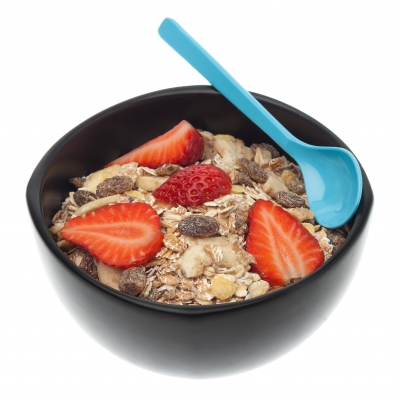 From keeping our immune system functioning to bowel regularity, our digestive systems do a lot for our everyday health.
From keeping our immune system functioning to bowel regularity, our digestive systems do a lot for our everyday health.
Dietary fiber as a regular part of your diet will promote lower cholesterol levels and improved heart health. Most of us consume about half of the fiber our bodies need to function correctly.
If we include fiber in the diets of our children now, we can make it a natural habit they continue into adulthood.
I asked registered dietitian Felicia D. Stoler, DCN, how parents can get inventive about ways to increase our family’s fiber intake. Stoler is the former host of TLC’s “Honey, We’re Killing the Kids,” and author of “Living Skinny in Fat Genes.”
Lisa Nelson, RD: How much fiber do we need?
Dr. Stoler: “Toddlers ages 1-3 need 19 grams of fiber daily. Children ages 4-8 years need 25 grams, about the same as adult women. Teenage boys and adult men should aim for 38 grams per day. That fiber requirement probably won’t be met by eating fast food. “A four-piece serving of chicken nuggets has just one gram of fiber. A six-inch turkey breast deli sandwich only has three grams.”
Lisa Nelson, RD: How do you get around the idea that a high-fiber diet means piling plates high with vegetables?
Dr. Stoler: “Sometimes playing ‘hide the fiber’ is the best way to improve a family’s nutrition.”
Lisa Nelson, RD: Can you give me some examples?
Dr. Stoler: “I’m always tossing ground flax seed into foods. One of my favorite tips is to use it as a thickener for tomato sauce or soup. Serving a lot of side dishes is a great way to load up on vegetables or grain-based foods. Along with a main course of poultry or fish, I prepare a lot of side dishes with beans, lentils and multiple grains. For flavor and color this time of year, toss in some cranberries.”
Lisa Nelson, RD: What about giving the family a high-quality fiber supplement?
Dr. Stoler: “I keep Sunfiber on the kitchen counter so it’s very convenient while I’m cooking. Since it’s odorless, tasteless and mixes easily into just about anything, it’s routinely my secret ingredient in a lot of foods from pancakes, waffles and muffins to chili, soup and yogurt. One scoop adds six grams of fiber, which is significant. It also helps support your family’s bone health because it supports better calcium and magnesium absorption.”
Lisa Nelson, RD: How can you add more fiber to kids’ party foods, especially if the event is at someone else’s home?
Dr. Stoler: “Offer to bring a snack for fall get-togethers. Kids go crazy for fruit kabobs. Just thread fresh melon balls onto wooden skewers. Then flip over half of the empty melon shell, and stick the skewers into it for a festive presentation. If you’re short on time, buy the pre-cut melon and stick the skewers in a Styrofoam ball from the craft store or invert a colander. When fruit is presented in an enticing way, people want to eat it.”
Lisa Nelson, RD: Do you have other creative tricks for getting kids to eat healthier?
Dr. Stoler: “Make sure plates are filled with colorful foods. Food that’s appealing stands a greater chance of getting eaten. Use cookie cutters to cut sandwiches made with high-fiber bread. Use a vegetable peeler to cut carrots or cucumbers into ribbons. Experiment with cutting other vegetables into fun shapes.”
Lisa Nelson, RD: What do you suggest for a high-fiber, family dessert?
Dr. Stoler: “Dress up fruits for dessert. The beauty of high-fiber desserts is that they fill you up, especially if you slow down and savor each bite. So you won’t be as tempted to over-indulge. Frozen grapes are fun and easy. Fruit cobblers are also a good choice for chillier evenings, especially if you sprinkle some Sunfiber into the mixture before baking. Making it with an oatmeal topping will add even more fiber and nutrients.”
Lisa Nelson, RD: Do you have any other suggestions for parents to encourage their kids to start eating more vegetables?
Dr. Stoler: “Include your children in creating menus, grocery shopping, gardening, setting the table and food preparation. “This may not only broaden their interest in trying different foods, it can also teach them important life skills around food such as budgeting money and time management skills. Passing on your knowledge will help them to be great parents!”
Dr. Stoler adds that Sunfiber, which she referenced, is well researched for its health benefits. Those studies are available at www.Sunfiber.com.
You can also access the free ecourse How to Lower Cholesterol in 8 Simple Steps at http://lowercholesterolwithlisa.com.
All the best,
Lisa Nelson RD
Image courtesy of phasinphoto / FreeDigitalPhotos.net
Sunlight to Lower Blood Pressure
 Let me begin by pointing out this finding is based off a small study of only 24 volunteers, but if the findings are accurate…what a relaxing way to promote a lower blood pressure!
Let me begin by pointing out this finding is based off a small study of only 24 volunteers, but if the findings are accurate…what a relaxing way to promote a lower blood pressure!
High blood pressure, also known as hypertension, exerts force against artery walls. If the force is high, it’ll cause microscopic tears that turn into scar tissue. This scar tissue promotes the accumulation of plaque in their artery walls causing arteries to narrow and harden.
According to the Centers for Disease Control, 67 million American adults have high blood pressure. Or to state another way…that is 1 in every 3 American adults.
Why this happens is still unknown.
It’s speculated that nitric oxide plays a role. The skin contains nitric oxide metabolites. It is hypothesized that UVA exposure mobilizes the nitric oxide into circulation resulting in beneficial cardiovascular effects.
Researchers speculate this may play a role in why those in the “darker north”, such as Scotland, have higher death rates associated with heart disease. Incidence of high blood pressure and cardiovascular disease rises in the winter and in relation to latitude.
The 24 volunteers in the study obtained the equivalent of 30 minutes of natural sunlight at noon on a sunny day in Southern Europe. Just in case lower blood pressure is caused by warming, the volunteers were protected from this warming effect. Researchers found volunteers blood pressure reduced by about five points with the effects lasting a half hour.
That doesn’t mean potential negative effects associated with too much sunlight, such as skin cancer, should be ignored in favor of this potential cardiovascular benefit. However, it be worth exploring a healthy balance of time in the sun against preventive measures to protect your skin.
If you are working to lower your blood pressure, access the free e-course 7 Natural Ways to Lower Blood Pressure at http://lowerbloodpressurewithlisa.com.
All the best,
Lisa Nelson RD
5 Steps for Heart Health, Starting Now

On the road to heart health, start with weight control. Reaching and maintaining a healthy weight promotes overall health and prevents many diseases, including heart disease. Living with extra weight, puts an increased burden on your heart muscle. Being overweight or obese puts you at increased risk for high blood pressure, type 2 diabetes, certain cancers, and other health
Here are five additional steps you can take for heart health:
1. Exercise more.
Being inactive is a major risk factor for heart disease. Regular exercise, particularly aerobic exercise, has many heart related benefits. For example, exercise will strengthen your heart, improves circulation, and lowers blood pressure.
2. Cut back on salt.
Salt can hide in places you may not expect. Read food labels. For some individuals, a high sodium diet is linked to high blood pressure. High blood pressure puts excess work on the heart and can lead to stroke and heart failure.
3. Avoid trans fat.
Trans fat increase LDL cholesterol, increase triglycerides and lowers HDL cholesterol. The FDA no longer recognizes trans fats as “generally recognized as safe” for use in food. Read food labels and select heart healthy oil when cooking, such as olive oil or canola oil.
Lower Blood Pressure with Vegetables
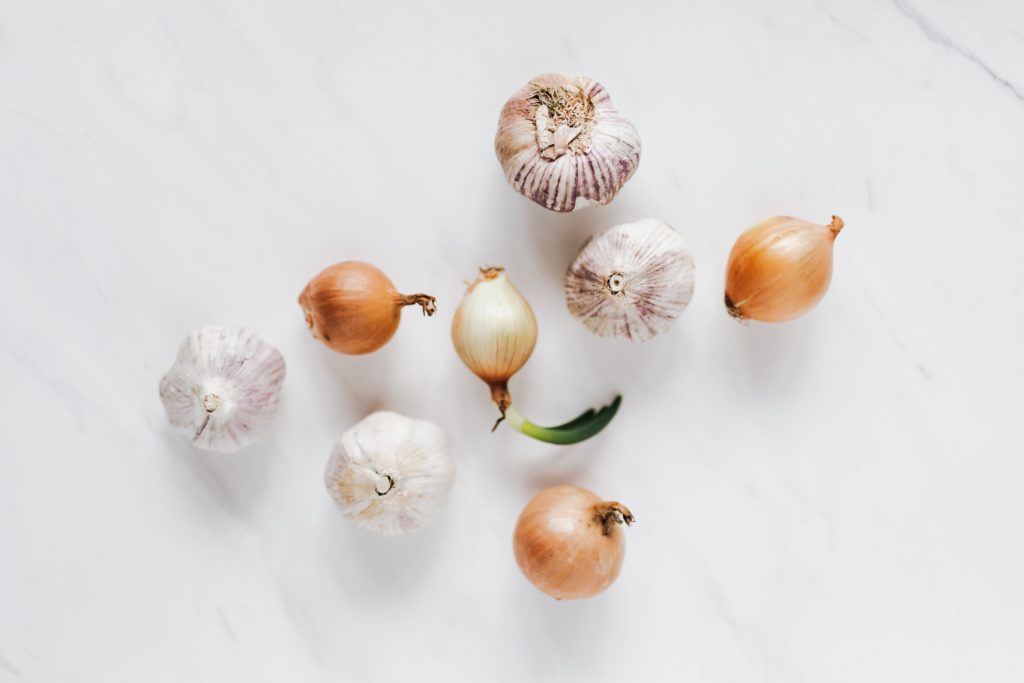
Are you familiar with the DASH (Dietary Approaches to Stop Hypertension) Diet? The DASH Diet is a very effective plan to lower blood pressure. However, it can be difficult to follow, especially if you don’t currently consume many vegetables. The DASH Diet calls for 4-5 servings of vegetables each day. One vegetable serving equals one-half cup or a one-cup serving of greens, such as spinach and lettuce.
Here are 3 easy to locate aromatic vegetables you can incorporate more into your daily diet for a variety of health benefits. Aromatic vegetables are used to add flavor to many dishes.
Onions – Probably one of the most often used aromatic vegetables in the United States. Onions are high in allyl sulfides, which aid in the fight against heart disease and cancer. Onions provide inulin, vitamin C, fiber manganese, and folate.
Celery – A great low-calorie addition to meals, celery promotes a lower blood pressure. Celery contains Vitamins A, C, and K, as well as potassium and quercetin. Quecetin is a flavonoid with anti-inflammatory properties to protect heart health.
Garlic – Reduces atherosclerosis, which is the thickening of your arterial walls, and reduces cancer risk.
Continue reading
